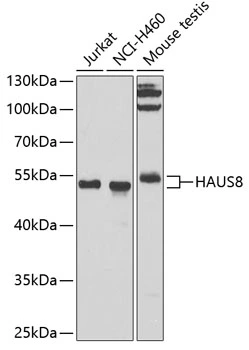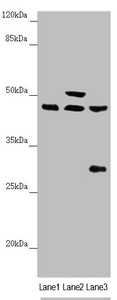
WB analysis of various sample lysates using GTX65898 Hice1 antibody. Dilution : 1:1000 Loading : 25microg per lane
Hice1 antibody
GTX65898
ApplicationsImmunoFluorescence, Western Blot, ImmunoCytoChemistry
Product group Antibodies
TargetHAUS8
Overview
- SupplierGeneTex
- Product NameHice1 antibody
- Delivery Days Customer9
- Application Supplier NoteWB: 1:500 - 1:2000. ICC/IF: 1:50 - 1:200. *Optimal dilutions/concentrations should be determined by the researcher.Not tested in other applications.
- ApplicationsImmunoFluorescence, Western Blot, ImmunoCytoChemistry
- CertificationResearch Use Only
- ClonalityPolyclonal
- ConjugateUnconjugated
- Gene ID93323
- Target nameHAUS8
- Target descriptionHAUS augmin like complex subunit 8
- Target synonymsDGT4, HICE1, NY-SAR-48, HAUS augmin-like complex subunit 8, HEC1/NDC80 interacting, centrosome associated 1, HEC1/NDC80-interacting centrosome-associated protein 1, Hec1-interacting and centrosome-associated 1, sarcoma antigen NY-SAR-48
- HostRabbit
- IsotypeIgG
- Protein IDQ9BT25
- Protein NameHAUS augmin-like complex subunit 8
- Scientific DescriptionHAUS8 is 1 of 8 subunits of the 390-kD human augmin complex, or HAUS complex. The augmin complex was first identified in Drosophila, and its name comes from the Latin verb augmentare, meaning to increase. The augmin complex is a microtubule-binding complex involved in microtubule generation within the mitotic spindle and is vital to mitotic spindle assembly (Goshima et al., 2008 [PubMed 18443220]; Uehara et al., 2009 [PubMed 19369198]).[supplied by OMIM, Jun 2010]
- Storage Instruction-20°C or -80°C,2°C to 8°C
- UNSPSC12352203




